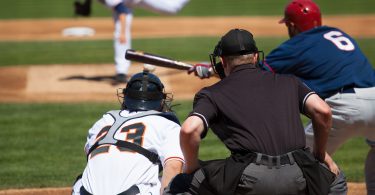The Situation:
There’s a runner on third, one out, and a 1-0 count. It’s a tie game in the top of the seventh. The nine-hitter is at the plate, and he’s struggled in his first 2 at-bats. The pitcher is throwing out of the windup. The runner on third takes a two-step lead and puts his hands on his knees, looking relaxed. The pitcher glances at the runner then goes into his windup. The runner takes a couple walking steps as the pitcher goes through the windup. The pitcher deals—ball two.
The Play:
The third base coach goes through a long set of signs as the runner and hitter watch. The hitter steps back into the box and the pitcher toes the rubber. He glances towards the runner on third.
The runner on third has taken three steps off the bag and is tense. He’s in an athletic position and is watching the pitcher closely. As the pitcher starts his windup, the runner breaks for the plate and the hitter squares to bunt. The pitcher was expecting the play and speeds through his normal windup throwing high and outside.
The Outcome:
The hitter lunges towards the pitch but can’t make contact. The catcher reaches out and catches the pitch. The runner is still about 10 feet from the plate. When he sees the hitter miss, he freezes. The catcher starts the rundown and the runner is quickly tagged out.
What Went Wrong:
Squeeze plays are hard because they’re rare and high-pressure. A team could go through an entire season and only try to execute a squeeze once or twice. So when the opportunity arises, it’s easy for players to get overexcited. In this situation, both the hitter and the runner made mistakes that gave the pitcher the chance to beat the squeeze.
The runner on third made two mistakes. First, the runner needs to take the same lead every single pitch. It doesn’t matter if a play is on or not—the lead has to be the same. By changing his lead, the runner tipped off the pitcher that a play was on, and gave the pitcher the chance to make an adjustment and speed through his windup. Second, the runner can extend his lead when the pitcher starts his motion, but the runner needs to wait to break for the plate until the pitcher’s throwing hand breaks from his glove. At that point, the pitcher will be focusing on the pitch and probably won’t be able to make an on-the-fly adjustment.
The hitter made the mistake of squaring around to bunt too early. Most teams will teach players to square to bunt early when they are sacrificing. But, like the runner breaking from third, when executing a squeeze the hitter needs to wait at least until the pitcher’s throwing hand breaks from the glove before squaring to bunt. This ensures the pitcher has very little time to adjust his motion and the location of his pitch.
You can’t overreact to big situations. Squeeze plays are high-risk, high-reward, and can cause players to get caught up in the moment. Slow things down, stay in the moment, and think the game.







